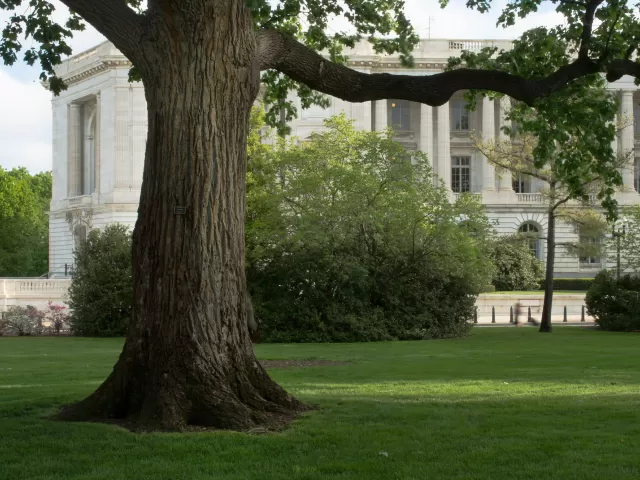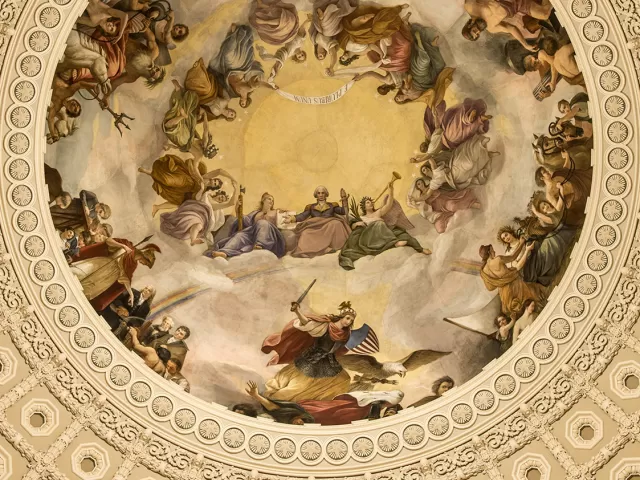Displaying 121 - 150 of 1030 Clear
Highlight
There is one original green ash tree still living on the U.S. Capitol campus today.
Highlight
There are three original Japanese pagoda trees still living on the U.S. Capitol campus today.
Highlight
There are two original Osage orange trees still living on the U.S. Capitol campus today.
Highlight
There are two original jujube trees still living on the U.S. Capitol campus today.
Highlight
There are three original tulip trees still living on the U.S. Capitol campus today.
Highlight
There is one original northern red oak tree still living on the U.S. Capitol campus today.
Highlight
There are three original bur oak trees still living on the U.S. Capitol campus today.
Highlight
Also known as basswood, the American linden is a native deciduous tree found throughout eastern North America. It is known for its broad, heart-shaped leaves, fragrant pale-yellow flowers that attract pollinators, and its smooth gray bark that develops ridges with age. Historically, its soft
Highlight
There is one original smoothleaf elm tree still living on the U.S. Capitol campus today.
Highlight
There are two original American elm trees still living on the U.S. Capitol campus today. About the Olmsted Originals Landscape architect Frederick Law Olmsted's 1874 General Plan for the U.S. Capitol Grounds sought to create a setting to accentuate the monumentality of the Capitol Building
Highlight
There are two original American beech trees still living on the U.S. Capitol campus today.
Highlight
Known for its fan-shaped leaves that turn from bright green in the summer to bright yellow in the fall, the ginkgo's earliest leaf fossils date back 270 million years. The ginkgo drops its leaves at the same time creating a solid yellow carpet under the tree. There are six original ginkgo trees
Highlight
There is one original horse chestnuet tree still living on the U.S. Capitol campus today.
Project
This two-phase project will replace the 85-year-old copper roof of the Library of Congress' John Adams Building.
Programs & Events
Article
At the Architect of the Capitol (AOC), the Capitol Grounds and Arboretum team works hard to promote green and sustainable practices around the Capitol campus.
Person
The Director of the Office of Safety and Code Compliance at the Architect of the Capitol leads agency efforts to provide a world-class safety culture, reduce injuries, and ensure compliance with safety, fire and environmental regulations.
Public Notice
Article
Located on the West Front grassy area near First Street, NW, and Garfield Circle.
Person
Angela Addison Freeman is the General Counsel for the Architect of the Capitol (AOC). As General Counsel, she leads a dynamic legal team that provides advice and counsel on matters involving appropriations and fiscal law, agency policies, construction and service contracts, employee relations and
Highlight
U.S. Capitol Grounds commemorative tree sponsored by the Wisconsin Congressional Delegation to honor the people of Wisconsin.
Person
The Chief of Staff supports the staff in driving the agency's mission of preserving and maintaining the historic buildings and grounds across the Capitol campus. They work to forge strong relationships with other legislative branch agencies to help the AOC in providing quality customer service to
Person
Director of Legislative and Public Affairs oversees the agency's strategic communications and interactions with Congress, agency employees, the media and the public. She is responsible for the development of congressional testimony, reporting requirements, briefings and legislative analysis. She
History & Discoveries
Article
Thomas Jefferson, inspired by skylights he saw in Paris, prevailed upon the Architect of the Capitol to include something similar in the U.S. Capitol's new chamber for the House of Representatives. However, all the skylights came to an untimely end.
Basic page
In accordance with legislation enacted in 2000, "Any State may request the Joint Committee on the Library of Congress to approve the replacement of a statue the State has provided for display in Statuary Hall" under certain conditions.
Behind the Scenes
Article
This innovative mode of transportation allows the dedicated gardening staff to move throughout the historic grounds of the U.S. Capitol with ease, all while carrying up to an impressive 300 pounds of gardening tools and horticultural materials.
History & Discoveries
Article
An in-depth look at the evolution of women in art at the U.S. Capitol.
History & Discoveries
Article
Learn more about the history of lighting this iconic building including the part of the Dome called the "tholos."
Behind the Scenes
Article
In the bleak winter, when most Washingtonians are looking to stay indoors, the Architect of the Capitol (AOC) Capitol Grounds and Arboretum team still spends a lot of time outside.
History & Discoveries
Article
While George Washington never actually graced the halls of the U.S. Capitol, his presence, influence and even his likeness, is everywhere including 35 pieces of art.
Highlight
At the end of the Revolutionary War, the British are shown laying down their arms against a symbolic sunset.
Highlight
Three Native Americans of northern Florida's Timucuan tribe are depicted near their village.



























